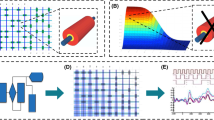Abstract
Computers with device feature sizes of a few nanometers—so-called nanocomputers—are expected within a few decades, but this expectation is accompanied by the realization that the boundary conditions of such systems differ substantially from those of current VLSI-based computers. Prominent among the concerns is the increased degree of permanent defects that will affect nanocomputers, such as defects caused by imperfections at the manufacturing stage, but also defects occurring later, possibly even during the use of these systems. New techniques to deal with defects are called for, but given the huge number of devices involved, such techniques may need to be self-contained: they need be applicable at local levels without outside control, even while computations continue to take place. This paper proposes an important element in such techniques, i.e. the localization of defects among a huge number of devices. It employs a cellular automaton-based architecture, and uses statistical techniques combined with randomly moving configurations in the cellular space to estimate defect locations.
Similar content being viewed by others
References
Durbeck, L. J. K. and Macias, N. J., “The cell matrix: an architecture for nanocomputing,” Nanotechnology, 12, pp. 217–230, 2001.
Heath, J. R., Kuekes, P. J., Snider, G. S., and Williams, R. S., “A Defect-Tolerant Computer Architecture: Opportunities for Nanotechnology,” Science, 280, pp. 1716–1721, 1998.
Isokawa, T., Kowada, S., Peper, F., Kamiura, N., and Matsui, N., “Online marking of defective cells by random flies,” in Proceedings of 7th Int. Conf. on Cellular Automata for Research and Industry (ACRI 2006), pp. 347–356, 2006.
Isokawa, T., Kowada, S., Peper, F., Kamiura, N., and Matsui, N., “Online isolation of defects in cellular nanocomputers,” Frontiers of Computer Science in China, 1, 4, pp. 397–406, 2007.
Isokawa, T., Kowada, S., Takada, Y., Peper, F., Kamiura, N., and Matsui, N., “Defect-Tolerance in Cellular Nanocomputers,” New Generation Computing, 25, 2, pp. 171–199, 2007.
Peper, F., Isokawa, T., Kouda, N., and Matsui, N., “Self-Timed Cellular Automata and their computational ability,”Future Generation Computer Systems, 18, pp. 893–904, 2002.
Peper, F., Lee, J., Abo, F., Isokawa, T., Adachi, S., Matsui, N., and Mashiko, S., “Fault-Tolerance in Nanocomputers: A Cellular Array Approach,” IEEE Transaction on Nanotechnology, 3, 1, pp. 187–201, 2004.
Peper, F., Lee, J., Adachi, S., and Mashiko, S., “Laying out circuits on asynchronous cellular arrays: a step towards feasible nanocomputers?,” Nanotechnology, 14, pp. 469–485, 2003.
Priese, L., “Automata and Concurrency,” Theoretical Computer Science, 25, pp. 221–265, 1983.
Siegel, S., Non-parametric statistics for the behavioral sciences, McGrow-Hill, New York, 1956.
Author information
Authors and Affiliations
Corresponding author
About this article
Cite this article
Isokawa, T., Peper, F., Kowada, S. et al. A Defect Localization Scheme for Cellular Nanocomputers. New Gener. Comput. 27, 85–105 (2009). https://doi.org/10.1007/s00354-008-0056-6
Received:
Revised:
Published:
Issue Date:
DOI: https://doi.org/10.1007/s00354-008-0056-6




